Crape Myrtles: Trees, Dwarf Plants and Shrubs (With Pictures)
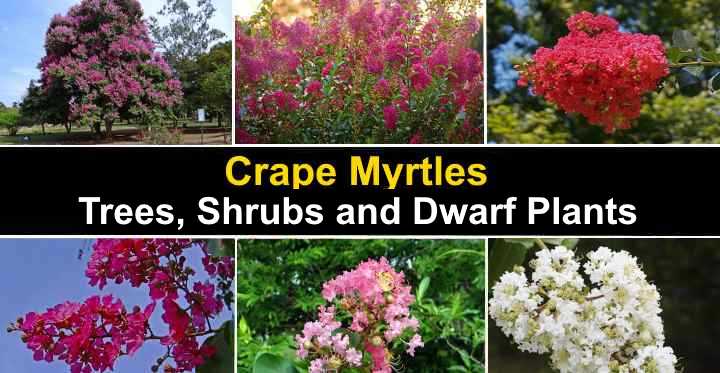
Crape myrtle is a genus of flowering trees and shrubs that thrive in warm climates. Popular in garden landscapes, crape myrtle trees produce masses of red, pink, purple, and white flowers throughout the summer. Crape myrtle trees and bushes have all-season interest due to their lush green foliage, colorful peeling bark, multiple stems, and bushy growth.
Crape myrtle trees, bushes, and dwarf shrubs are in the plant genus Lagerstroemia. The bushy shrubs and trees have deciduous or evergreen foliage. But it’s their spectacular clusters of flowers that are the main attractions. The beautiful flower spikes—called panicles—are made up of wrinkled petals with a texture like crepe paper.
Crape myrtles produce stunning pastel-colored flowers in spring, summer, and fall. Crape myrtles enhance garden landscapes when they get at least six hours of sunshine and grow in moist soil.
There are varieties of dwarf crape myrtle trees that are ideal landscaping plants for warm climates.
Some kinds of crape myrtle bushes are small enough to grow in containers on patios, decks, balconies, or as foundation plants.
Flowering crape myrtles are relatively resistant to drought and require minimal pruning to keep their shape.
Crape myrtles are popular as ornamental trees and shrubs. Large and small crape myrtle trees grow best as specimen trees, lawn trees, informal flowering hedges, and shrub borders. Most species of crape myrtle trees thrive in USDA zones 7 through 10.
This article is a complete guide to magnificent examples of crape myrtle trees, dwarf bushes, and shrubs. Pictures of the large flowering shrubs and descriptions of their flowers, foliage, and bark will help you choose the perfect specimen for your garden landscape.
How to Care for Crape Myrtle Trees
To care for crape myrtle trees (Lagerstroemia), grow them in full sun or partial shade where they get six hours of sunlight daily. Plant in well-drained soil and water the trees regularly during the growing season to keep the ground moist. Prune lightly in early spring and deadhead to encourage plenty of flowers.
How Big Do Crape Myrtle Get?
Crape myrtle trees grow between 15 and 25 ft. (4.5 – 7.5 m) tall with spreading, a vase-shaped, flat-topped crown measuring 6 to 15 ft. (1.8 – 4.5 m) broad. Semi-dwarf crape myrtle bushes grow between 4 and 10 ft. (1.2 – 3 m) tall. And dwarf or miniature crape myrtle shrubs don’t grow taller than 4 ft. (1.2 m). Some of the smallest crape myrtles are only around 2 ft. (60 cm) tall.
Crape Myrtle Colors
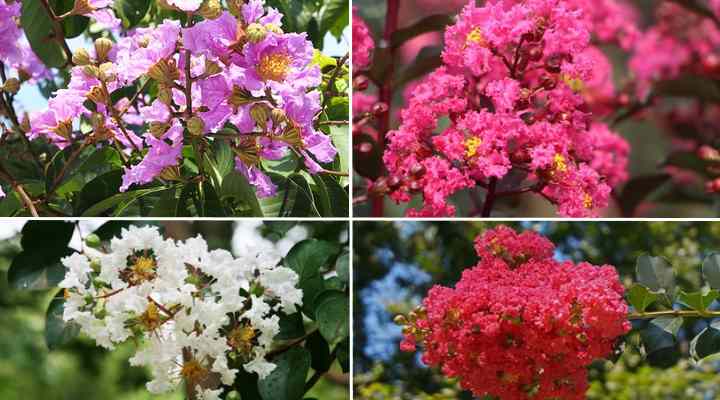
Crape myrtle flowers can be in shades of red, pink, purple and white colors
Crape myrtle trees and bushes come in a wide range of colors, including shades of white, pink, red, and purple. Some of the best pink crape myrtle cultivars are ‘Chickasaw,’ ‘Delta Blush,’ and ‘Pink Velour.’ The best red crape myrtles are ‘Tonto,’ ‘Raspberry Sundae,’ and ‘Red Rocket.’ The best white crape myrtles are ‘Natchez,’ ‘Acoma,’ and ‘New Snow.’
Fact about crape myrtle flowers: Because the shape of the showy flower clusters resembles lilac bush flowers, crape myrtles are sometimes called “Lilac of the South.”
When Do Crape Myrtles Bloom?
Crape myrtle trees, bushes, and shrubs produce flowers throughout the summer. Some species of crape myrtle (Lagerstroemia) start blooming as early as spring or the start of summer. Depending on the variety, crape myrtles bloom for between 90 and 120 days. Their long blooming period means many trees are still blooming in late fall or before the first frost.
Dwarf Crape Myrtle
Dwarf crape myrtle trees are large shrubs that are perfect for compact gardens. Typically, dwarf myrtle trees grow between 6 and 10 ft. (1.8 – 3 m) tall. Species of dwarf myrtle trees can be single-trunked specimens with a large spreading crown. The most popular dwarf crape myrtle, Lagerstroemia indica x fauriei ‘Acoma,’ is a multi-stemmed shrub-like tree with masses of white flowers and a rounded spreading crown.
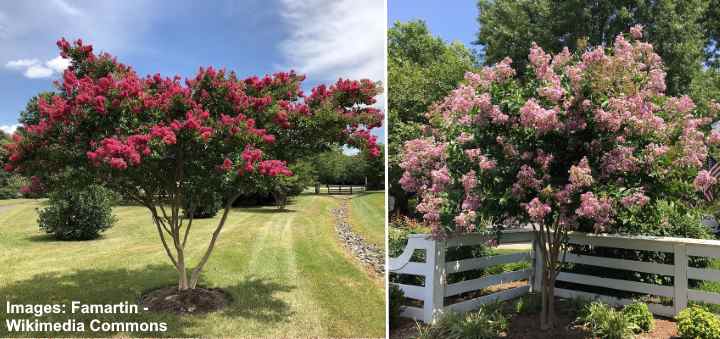
Crape myrtle are shrub-like trees with multiple stems
Crape Myrtle Bushes
Crape myrtle bushes are small plants, ideal for growing as foundation plantings or in containers. Usually, crape myrtle bushes only grow a few feet high. For example, the Lagerstroemia indica ‘Delta Blush’ is a weeping crape myrtle with light pink flowers and grows no taller than 18” (45 cm) high.
Types of Crape Myrtle Trees (With Pictures)
Here are some of the best varieties of crape myrtles for your front or backyard.
Natchez Crape Myrtle (Lagerstroemia indica x fauriei ‘Natchez’)
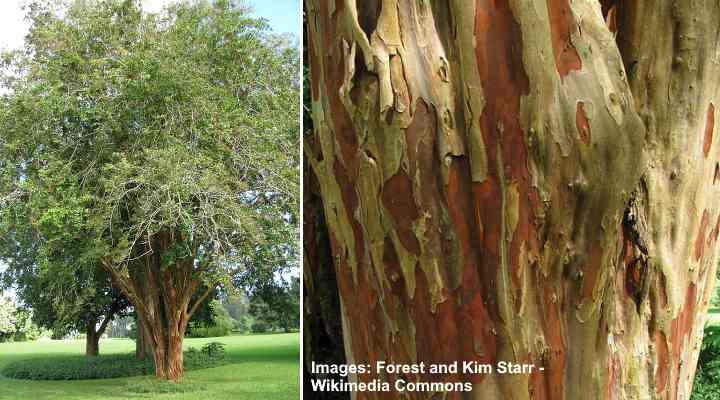
Natchez crape myrtle tree (left) and close up image of the bark (right)
The ‘Natchez’ crape myrtle is a medium sized tree or large shrub with huge white showy flowers that bloom in mid-summer and last until fall. This crape myrtle hybrid has spreading vase-shaped growth with upward growing branches. The snow-white flowers create a stunning contrast against the dark green glossy foliage. After the flowers drop, the leaves turn brilliant shades of orange and red in the fall.
‘Natchez’ crape myrtle trees grow between 20 and 30 ft. (6 – 9 m) high. The easy-to-grow ornamental tree thrives in full sun and is resistant to drought when established. Grow in USDA zones 7 through 10.
Crape myrtle flowers
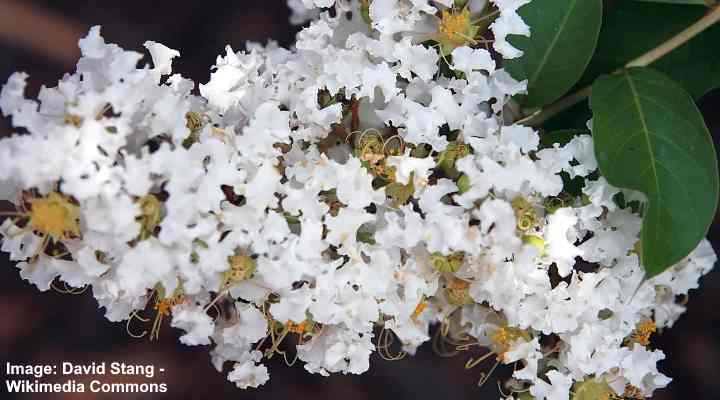
White flowers of Natchez crape myrtle
‘Natchez’ crape myrtle is an outstanding tree that produces large, brilliantly white flower clusters. The showy, ruffled flower panicles grow up to 12” (30 cm) long and produce a snow-like effect when they bloom for a few months from mid-summer.
Arapaho Crape Myrtle (Lagerstroemia indica x faueri ‘Arapaho’)
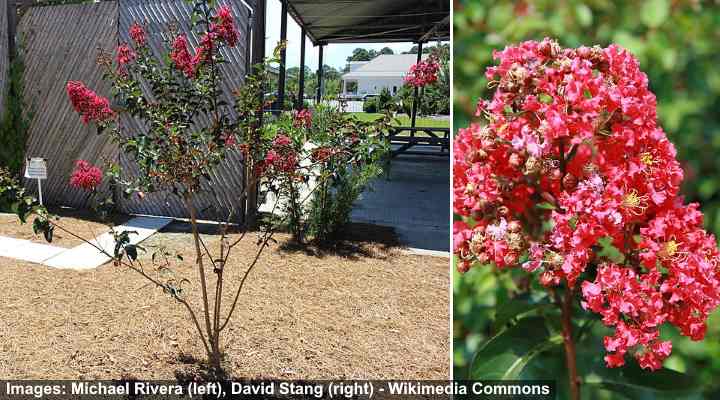
Young Arapaho crape myrtle (left) and close up picture of the red flowers (right)
The ‘Arapaho’ crape myrtle is a small to medium-sized tree or large shrub that produces masses of red, crepe-paper-like flowers. The sizeable feathery flower panicles start blooming in summer and last until fall. The shiny, dark green leaves and peeling bark give this Lagerstroemia tree spectacular all-season interest. This drought-tolerant plant requires little care in warm climates.
‘Arapaho’ crape myrtle grows between 15 and 20 ft. (4.5 – 6 m) high with a 10 to 20 ft. (3 – 6 m) spread. This crape myrtle species grows best as a specimen tree. However, with regular pruning, you can grow it as a privacy hedge or at the corner of your house.
Crape myrtle flowers
The bright red flowers on ‘Arapaho’ crape myrtles cover these large shrubs or small trees. Each large flower cluster is made up of a mass of crinkled red petals.
Tuscarora Crape Myrtle (Lagerstroemia indica x fauriei ‘Tuscarora’)
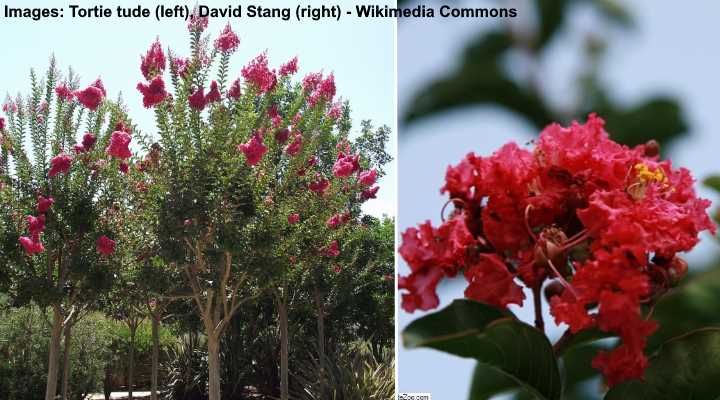
Tuscarora crape myrtle (left) and dark pink flowers (right)
The ‘Tuscarora’ crape myrtle is a small landscaping tree that bursts into coral-pink colors in early summer. Like many crape myrtle species, the ‘Tuscarora’ variety has shiny green leaves, mottled cinnamon-tan bark, and spreading rounded growth. This large shrub-like tree grows best in full sun in USDA zones 7 through 10.
‘Tuscarora’ crape myrtle trees grow up to 15 ft. (4.5 m) tall. The low-maintenance ornamental tree is ideal for planting as a large privacy screen, lawn tree, or small specimen tree for a front or backyard.
Crape myrtle flowers
The masses of deep pink flower clusters on the ‘Tuscarora’ crape myrtle cover the tree. The flower panicles are made up of crepe-papery flowers that hold their color for all summer and fall.
Muskogee Crape Myrtle (Lagerstroemia indica x fauriei ‘Muskogee’)

Muskogee crape myrtle (left) and close up picture of the pink-pale purple colored flowers (right)
‘Muskogee’ crape myrtle is a fast-growing, compact ornamental tree or large shrub with impressive lavender-colored flowers. The light-lilac flowers on the ‘Muskogee’ last an incredible 120 days or longer during hot, dry summers. This crape myrtle species features a large, spreading rounded crown along with multi-colored brown, tan, and gray bark.
The ‘Muskogee’ crape myrtle grows between 15 and 20 ft. (4.5 – 6 m) high with a massive crown to match its height. The all-season interest of ‘Muskogee’ crape myrtles is its lavender flowers, peeling bark, and reddish-orange fall colors.
Crape myrtle flowers
‘Muskogee’ crape myrtle has large lavender-pink flowers made up of “crepe-paper” petals bloom from early summer until fall. The ‘Muskogee’ crape myrtle flowers range in size from 8” to 16” (20 – 40 cm).
Catawba Crape Myrtle (Lagerstroemia indica ‘Catawba’)
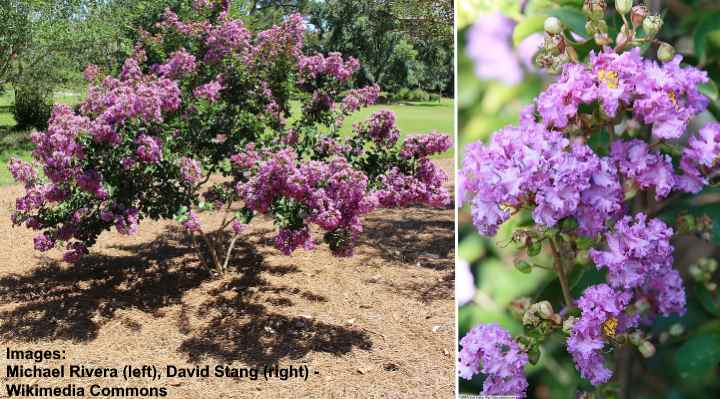
Catawba crape myrtle (left) and close up image of the purple flowers (right)
The ‘Catawba’ crape myrtle is a stunning example of small crape myrtle tree or medium-large shrub that has purple flowers. This crape myrtle cultivar blooms in late summer. Its purple flower clusters contrast with the glossy green, dense foliage. In fall, the leathery green leaves turn a breathtaking orange-red color before dropping to reveal smooth multi-colored bark.
‘Catawba’ crape myrtle trees grow between 10 and 15 ft. (3 – 4.5 m) tall with a similar-sized spread. Grow this multi-trunked crape myrtle species in USDA zones 7 through 9.
Crape myrtle flowers
The purple ‘Catawba’ crape myrtle flowers grow profusely from late summer until late fall. The ruffled purple flowers form large clusters that look like conical spikes.
Centennial Spirit Crape Myrtle (Lagerstroemia Indica ‘Centennial Spirit’)
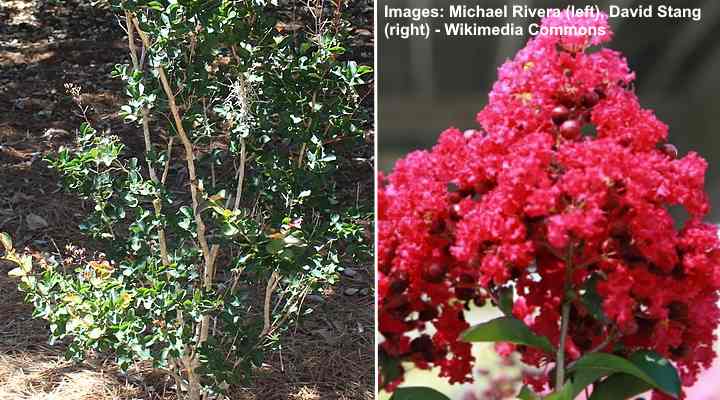
Young Centennial Spirit crape myrtle (left) and close up picture of the red flowers (right)
The ‘Centennial Spirit’ crape myrtle is a shrubby tree that explodes into stunning rose-red colors when it blooms. Large red crape myrtle flowers, peeling gray bark, lush green foliage, and red fall colors are the attractive features of ‘Centennial Spirit.’ The attractive small tree is a popular landscaping tree in Southern gardens.
‘Centennial Spirit’ crape myrtle trees grow up to 20 ft. (6 m) tall. As with all crape myrtles, it enjoys full sun. Its compact growth and ornamental characteristics make the small tree ideal for planting along driveways, specimen trees, or shade trees in backyards.
Sioux Crape Myrtle (Lagerstroemia indica x fauriei ‘Sioux’)
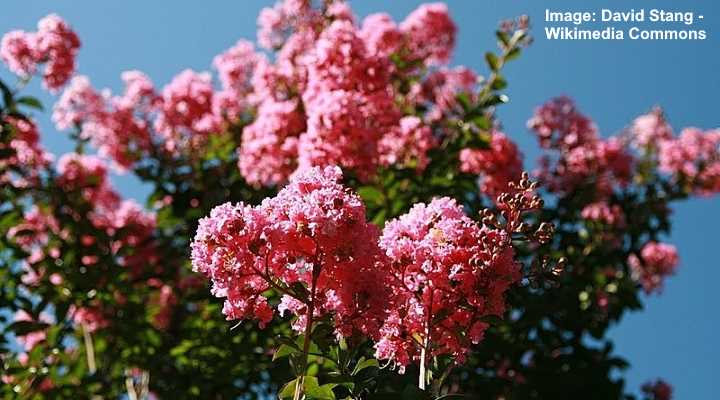
Sioux crape myrtle with bright pink flowers
The ‘Sioux’ crape myrtle is a small attractive tree that produces masses of bright pink, crinkly, showy flowers throughout the summer. This crape myrtle hybrid is ideal for growing in hot, dry climates. The lush, shiny foliage, attractive burgundy fall colors, and peeling tan-colored bark give this tree a year-long appeal.
‘Sioux’ crape myrtle trees grow between 12 and 15 ft. (3.5 – 4.5 m) and have a spread up to 10 ft (3 m). Compared to other crape myrtle trees, the ‘Sioux’ tree has vase-shaped growth with a flat, rather than rounded, top.
Dynamite Crape Myrtle (Lagerstroemia indica ‘Whit II’)
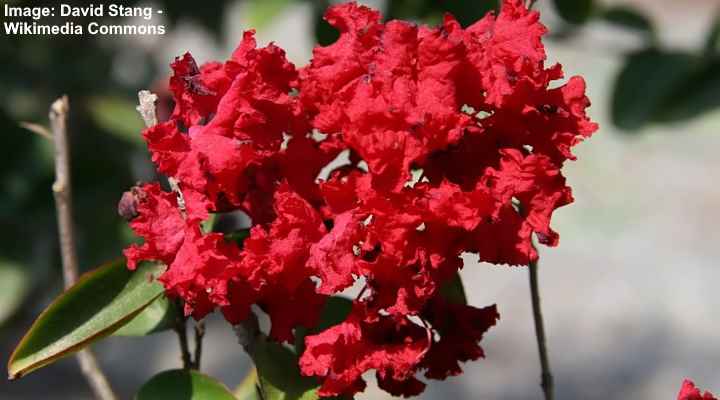
Red flowers of Dynamite crape myrtle
The crape myrtle ‘Dynamite’ is a small variety of ornamental tree that has brilliant red flowers. This fast-growing crape myrtle blooms from mid-summer with masses of showy flower clusters that turn the tree bright cherry-red. The tree enhances garden aesthetics during other seasons due to its attractive rounded shape, crimson-red spring foliage that turns dark green, then orangey-red colors in the fall.
‘Dynamite’ crape myrtle trees grow between 10 and 15 ft. (3 – 4.5 m) tall. These crape myrtle trees also have an impressive spread—up to twice the height of the tree.
Tonto Crape Myrtle (Lagerstroemia indica ‘Tonto’)
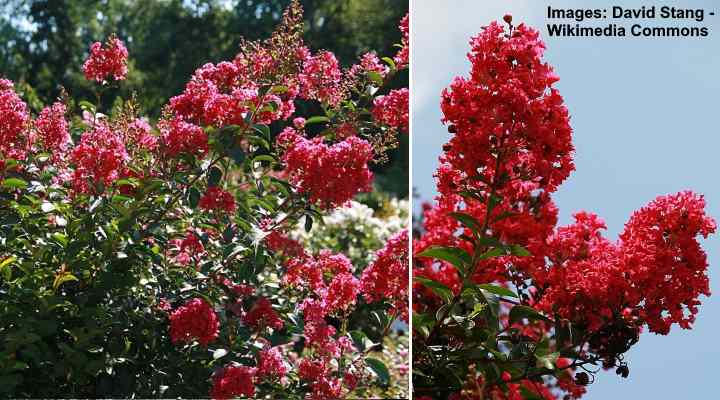
Tonto crape myrtle (left) and close up image of the red flowers (right)
The ‘Tonto’ crape myrtle is a small shrub-like tree that blooms with brilliantly colored magenta flowers. The vibrant pinkish-red flowers add plenty of color to summer gardens. In addition to spectacular summer colors, the ‘Tonto’ Lagerstroemia tree has other seasonal interests. Reddish-cinnamon bark, purple-red fall foliage, and an attractive shape make this crape myrtle a prized landscaping tree.
‘Tonto’ crape myrtle trees grow around 10 ft. (3 m) tall with a similar spread. These small shrubby trees are best growing as a specimen tree, informal privacy screen, or foundation planting.
Acoma Crape Myrtle (Lagerstroemia indica x fauriei ‘Acoma’)
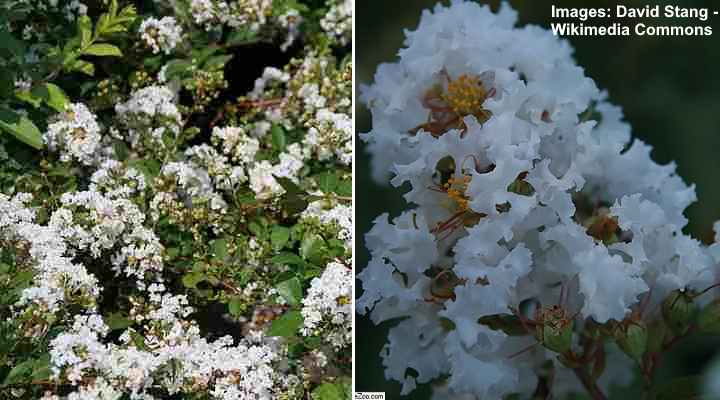
Acoma crape myrtle (left) and close up picture of the white flowers (right)
The ‘Acoma’ crape myrtle is a dwarf tree that brightens summer gardens with its showy cluster of pure white, ruffled flowers. ‘Acoma’ crape myrtle is a weeping type of landscape tree that has slightly drooping branches and flower clusters. ‘Acoma’ crape myrtles are ideal for growing in small, compact gardens or as a specimen tree.
‘Acoma’ crape myrtle dwarf trees grow around 10 ft. (3 m) tall.
Rhapsody in Pink Crape Myrtle (Lagerstroemia indica ‘Whit VIII’)
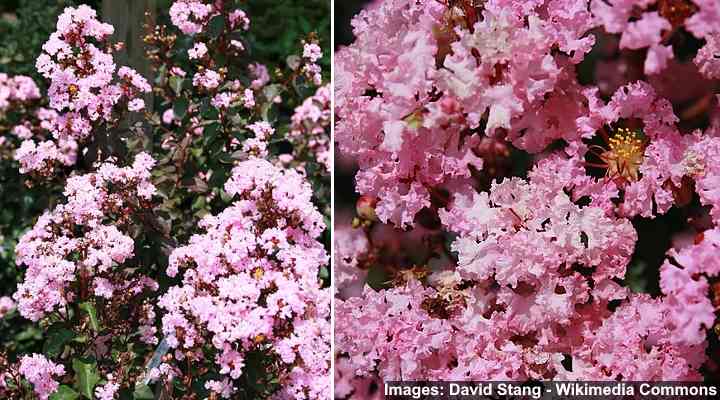
Beautiful light pink flowers of Rhapsody in Pink crape myrtle
‘Rhapsody in Pink’ crape myrtle is a small tree or shrub that produces clusters of feathery, light-pink flowers. This deciduous tree has leathery dark green leaves, showy flowers with crinkled pink petals, and lush foliage that turns bright orangey-red in the fall. An attractive winter feature of ‘Rhapsody in Pink’ is its pinkish-gray exfoliating smooth bark.
‘Rhapsody in Pink’ crape myrtle trees grow between 6 and 10 ft. (1.8 – 3 m) with a spread of up to 12 ft. (3.5 m). You can grow crape myrtle trees as a flowering hedge plant, specimen plant, or in a container at an entranceway.
Pink Velour Crape Myrtle (Lagerstroemia indica ‘Pink Velour’)

Close up picture of the deep pink-magenta flowers of Pink Velour crape myrtle
The ‘Pink Velour’ crape myrtle is a small shrub-like tree with spectacular magenta-pink clusters of crumpled flowers. From all the crape myrtles on this list, ‘Pink Velour’ is one of the longest blooming varieties. The landscaping tree starts blooming in mid-summer, and the vibrant flowers last well into late fall.
The ‘Pink Velour’ crape myrtle tree has gray peeling bark, orange-brown colored leaves in the fall, and dark-colored seeds that last through to winter. ‘Pink Velour’ crape myrtles thrive in USDA zones 6 through 9 and grow to around 6 ft. (1.8 m) tall.
Petite Plum Crape Myrtle (Lagerstroemia indica ‘Monum’)
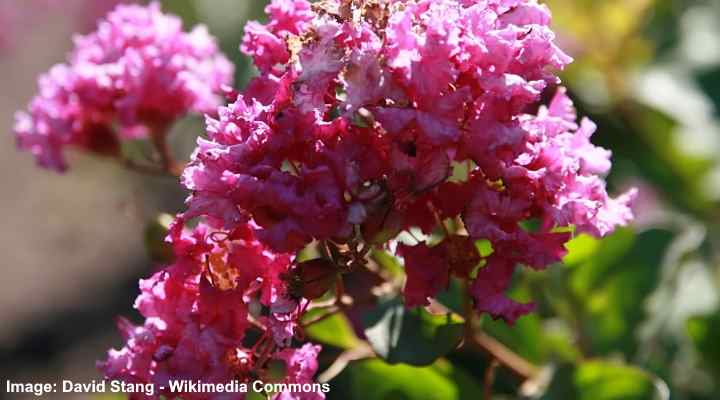
Petite Plum crape myrtle flowers
The ‘Monum’ crape myrtle gets its common name—petite plum—from its dwarf growth nature and showy plum-colored flowers. The clusters of ruffled purplish-pink flowers bloom for a long time throughout the summer. Due to the shrub’s small size, it’s ideal for planting in containers, in the front of the house, along borders, or as an informal hedge.
Petite plum crape myrtle trees grow around 5 ft. (1.5 m) tall.
Chickasaw Crape Myrtle (Lagerstroemia indica x fauriei ‘Chickasaw’)
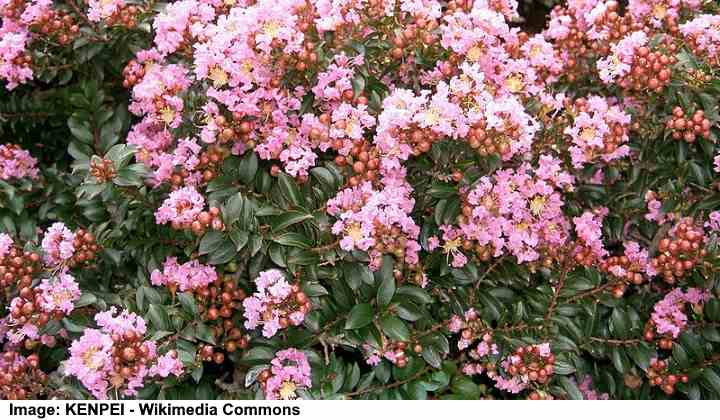
Chickasaw crape myrtle bush
The ‘Chickasaw’ crape myrtle is a miniature shrubby plant that produces light pink flowers when in bloom. This crape myrtle species is a slow-growing plant that takes about seven years to reach its mature height of 2 ft. (0.6 m). ‘Chickasaw’ crape myrtles have leathery green leaves and pinkish-lavender flowers that bloom from summer until frost.
Crape Myrtle ‘Delta Blush’ (Lagerstroemia indica ‘Delta Blush’)
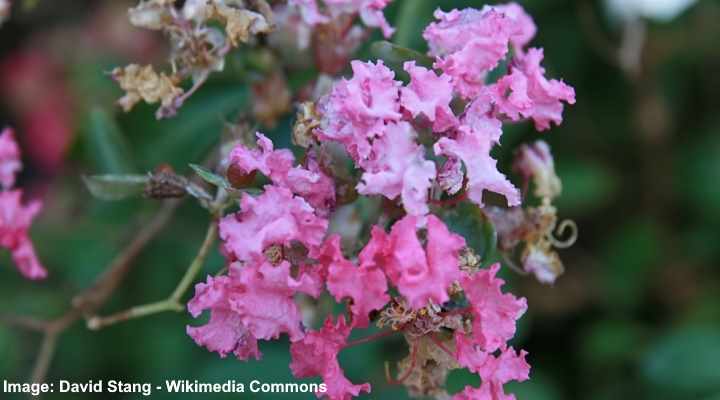
Crape myrtle ‘Delta Blush’ pink flowers
The ‘Delta Blush’ crape myrtle is a miniature weeping shrub with papery pink flowers when in bloom. The small bushy crape myrtle doesn’t grow taller than 18” (45 cm). This sun-loving variety of crape myrtle needs warm climates to bloom. You can grow this crape myrtle plant in compact, urban gardens to add summer colors to your garden landscape.
Read our extensive guide to planting and caring for crape myrtles.
Related articles:
